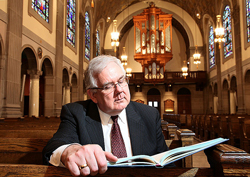by Timothy Robson

The new two-manual and pedal organ, which sits in a renovated rear organ gallery, is modeled on organs of 17th-century Holland and northern Germany. Its pitch and tuning enable the organist to simulate the sounds that would have been heard by the composers of the time, the late Renaissance and Baroque periods. The organ has nineteen ranks of pipes. The only electrical components of the organ are the lamp above the key desk and the blower that supplies the wind; the key and stop action are all mechanical. The Church of the Covenant also revised the acoustics of the sanctuary to enliven the reverberation of the space.
It is a pleasure to report that the new organ is a complete success. The sounds of the individual stops are distinctive, but when combined they created a cohesive and surprisingly powerful ensemble for such a small organ. The morning service demonstrated the capabilities of the organ for accompanying congregational hymn singing and choral works. Mr. Christie’s recital in the afternoon showed the instrument’s versatility as a solo instrument. I had the opportunity to play the organ in mid-March as the builders were finishing the voicing of the pipes, and I can report that besides sounding fine, the organ’s key action is crisp, yet subtle and responsive. It is a delight to play and should draw a large following of potential performers.
James David Christie is renowned for his historically-informed performances of early organ music, and on this recital we were treated to a survey of music spanning the late-16th century with works by Giovanni Gabrieli, Jan Pieterszoon Sweelinck and Samuel Scheidt, through the later Baroque, with works by Georg Böhm, and Dieterich Buxtehude and Johann Sebastian Bach. Much of the repertoire on the program is rarely heard, but each piece demonstrated a particular capability of the Newberry organ.
The Covenant Choir and guest string, brass and organs, joined Mr. Christie for Gabrieli’s Omnes gentes, plaudite manibus in 16 voices, and Heinrich Schütz’s setting of the 150th Psalm, Alleluja! Lobet den Herren in seinem Heiligtum. Mr. Christie introduced each with an improvisatory intonation and joined the musical texture at climactic moments, adding not so much volume to the sound as added depth of color. The choral singers and instrumentalists were placed in the two side transepts near the front of the church, as well as in the rear gallery. It was the original stereo experience. Mr. Moyer conducted from one of the transepts and managed to keep the whole thing together, despite a few tentative moments on the part of his performers.

The mid-17th-century Italian Bernardo Storace based his perky Ciacona in C on the same (or at least very similar) repeated bass line that Claudio Monteverdi used for his famous Zefiro torna. Storace is quite adventurous in his use of different keys and harmonies.
One of the most delightful pieces on the program was the short Fuga in e (Fugue in E minor) by the little-known German Johann Heinrich Buttstett, a pupil of Johann Pachelbel. The fugue subject, in a quick tempo, is a series of repeated (and often ornamented) 16th notes. The subsequent entries of the subject also pick up the note repetitions, until there are whole chords that are being repeated. It was a great test of the organ’s wind supply and action; would it have the wind to stand up to all of those notes, and is the action quick enough to play the repetitions over an extended period? The organ, and Mr. Christie, survived intact.
The Newberry organ’s “modified meantone” temperament sounds exceedingly beautiful in keys without too many sharps or flats; keys more remote from C Major sound increasingly out of tune and less pleasing. Our ears have become attuned to equal temperament, so an instrument capable of pure tuning is very striking to hear. The two brief works by Johann Sebastian Bach (Fuga sopra il Magnificat, BWV 733, and the quiet choral prelude Wenn dich Unglück tut greifen an, BWV 1104) tested the limits of the new organ’s temperament. The concert ended with a dazzling performance of Buxtehude’s virtuosic Praeludium in g, BuxWV 148, with its elements of fantasy and closing chaconne bass and highly ornamented upper voices.
The new Newberry organ by Richard, Fowkes & Co. is a triumph, and although perhaps Mr. Christie’s statement that it is Cleveland’s “crown jewel” in last week’s ClevelandClassical preview is arguable, it is nonetheless a major new addition to the cultural life of Northeast Ohio. All concerned are to be congratulated, but especially the Church of the Covenant and donors for their daring foresight to install an instrument that will bring pleasure for generations to come.
Published on ClevelandClassical.com May 14, 2013
Click here for a printable version of this article.



